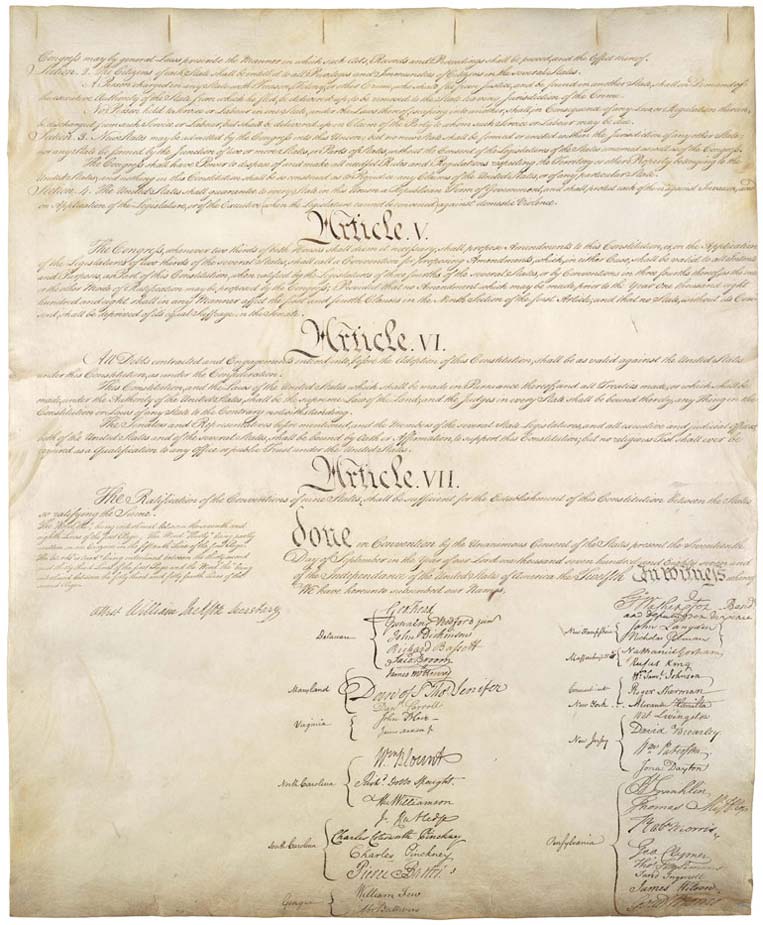| United States Constitution | |
|---|---|
 |
|
| The U.S. Constitution | |
| Preamble | |
| Articles of the Constitution | |
| I ‣ II ‣ III ‣ IV ‣ V ‣ VI ‣ VII | |
| Amendments to the Constitution | |
| Bill of Rights | |
| I ‣ II ‣ III ‣ IV ‣ V ‣ VI ‣ VII ‣ VIII ‣ IX ‣ X | |
| Additional Amendments | |
| XI ‣ XII ‣ XIII ‣ XIV ‣ XV ‣ XVI ‣ XVII ‣ XVIII ‣ XIX ‣ XX ‣ XXI ‣ XXII ‣ XXIII ‣ XXIV ‣ XXV ‣ XXVI ‣ XXVII | |
| View the Full Text | |
| Original Constitution | |
| Bill of Rights | |
| Additional Amendments |
Article 5 of the U.S. Constitution is one which discusses how the Constitution might be changed, what amendments can be made, and discusses the manner in which the changes can and should be made. The only way that changes can be made to the Constitution, is if new amendments are added to it; no other clause or forms of change can take place, apart from this, when the government, or any one party is attempting to make new rules or amend the Constitution.
Understanding the Article
This article is broken down in to just one single paragraph form, that discusses the changes, and how they can be made to the Constitution. Although the other articles are further broken down to distinct sections, and further broken down in to separate clauses, Article 5 is only a single paragraph that discusses the methods in which a change or addition can be made to the U.S. Constitution.
The terms break down to include:
– Congress, when 2/3 deem it is necessary, will propose the amendments that should be made to the Constitution.
– If the legislature of 2/3 of the states can call for a convention changes to be made, this is another way that amendments can be discussed and proposed.
The article further breaks down the way in which the article allows Congress to make changes to the Constitution, and what terms have to be present, in order for those changes to be made, and eventually accepted, in order to be voted in to the Constitution.
How Congress Can Change the Constitution
 If it is believed by Congress that changes should be made to the Constitution, it requires at a minimum, 2/3 of the House of Representatives, as well as the Senate, to propose that amendment change to the Constitution. This alone does not mean a change is going to be made, or an amendment will be added, it simply puts it in to the realm that a proposed change will be looked at, and then later voted on, to decide what changes will be made (if any) to the Constitution.
If it is believed by Congress that changes should be made to the Constitution, it requires at a minimum, 2/3 of the House of Representatives, as well as the Senate, to propose that amendment change to the Constitution. This alone does not mean a change is going to be made, or an amendment will be added, it simply puts it in to the realm that a proposed change will be looked at, and then later voted on, to decide what changes will be made (if any) to the Constitution.
For this to take place, Congress must call an a convention to make changes or amendments to the Constitution, in order for the vote to take place, and for the proposed changes to be further discussed by the members of the House and the Senate that are going to be voting on it.
During this period of time, the President does not have much power or leverage room. The President is limited, and is not able to do anything to hurry the process along, or to slow it down, until the amendments meeting is concluded, and votes are counted. If something is proposed and passed, before it becomes signed in to law, or added (amended), this is where the President has the power to step in, and possibly stop any changes from being made to the Constitution.
The Process of Ratifying an Amendment
Once the amendment has been proposed officially, it must be approved. The approval has to be by at least 3/4 of all states that are included in the vote. Once a sufficient number of states accept the proposed change and choose to ratify the Constitution, the new proposed change then becomes a law in all U.S. states, even those that opposed the change or ratification from taking place.
In certain cases, states will ratify amendments that have already been passed, in order to symbolize how important that amendment is, not only to the state, but also to the Constitution. The outlawing of slavery, the 13th amendment, was ratified by all states, as a symbolic importance to the nation, and a change that had to be made.
The 5th article does not go in to detail or discuss the period of time that each state legislature has to make a decision and ratify an amendment. But, when the proposed ratification is set out to be voted on, Congress does have the power to set a specific time period or deadline, by when votes have to be placed, in order to avoid certain states dragging on the process, and avoiding a particular change or law.